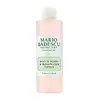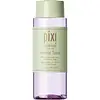What's inside
What's inside
 Key Ingredients
Key Ingredients

No key ingredients
 Benefits
Benefits

 Concerns
Concerns

 Ingredients Side-by-side
Ingredients Side-by-side

Water
Skin ConditioningAloe Barbadensis Leaf Juice
Skin ConditioningGlycerin
HumectantHamamelis Virginiana Water
AstringentPolysorbate 20
EmulsifyingRosa Damascena Flower Water
MaskingRosa Hybrid Flower Extract
Skin ConditioningHamamelis Virginiana Leaf Extract
Skin ConditioningRosa Damascena Flower Oil
MaskingPentylene Glycol
Skin ConditioningChlorphenesin
AntimicrobialCaprylyl Glycol
EmollientParfum
MaskingPotassium Sorbate
PreservativeSodium Benzoate
MaskingSodium Chloride
MaskingCitric Acid
BufferingPhenoxyethanol
PreservativePropylene Glycol
HumectantBenzoic Acid
MaskingGeraniol
PerfumingCitronellol
PerfumingCI 19140
Cosmetic ColorantCI 17200
Cosmetic ColorantWater, Aloe Barbadensis Leaf Juice, Glycerin, Hamamelis Virginiana Water, Polysorbate 20, Rosa Damascena Flower Water, Rosa Hybrid Flower Extract, Hamamelis Virginiana Leaf Extract, Rosa Damascena Flower Oil, Pentylene Glycol, Chlorphenesin, Caprylyl Glycol, Parfum, Potassium Sorbate, Sodium Benzoate, Sodium Chloride, Citric Acid, Phenoxyethanol, Propylene Glycol, Benzoic Acid, Geraniol, Citronellol, CI 19140, CI 17200
Water
Skin ConditioningRosmarinus Officinalis Leaf Water
MaskingGlycerin
HumectantPropanediol
SolventPEG-40 Hydrogenated Castor Oil
EmulsifyingMethyl Gluceth-20
HumectantCaprylic/Capric Triglyceride
MaskingPEG-8
HumectantPanthenol
Skin ConditioningMagnesium Ascorbyl Phosphate
AntioxidantSodium Hyaluronate
HumectantLecithin
EmollientPolysorbate 20
EmulsifyingOenothera Biennis Flower Extract
AstringentHibiscus Rosa-Sinensis Flower Extract
HumectantSodium Acrylates Copolymer
Palmitoyl Tripeptide-28
Skin ConditioningHydroxypropyl Cyclodextrin
MaskingRetinol
Skin ConditioningPhenoxyethanol
PreservativeJasminum Officinale Flower/Leaf Extract
MaskingLavandula Angustifolia Flower/Leaf/Stem Extract
MaskingEugenia Caryophyllus Flower Extract
AstringentVitis Vinifera Fruit Extract
Skin ConditioningSodium Citrate
BufferingDisodium EDTA
Citric Acid
BufferingEthylhexylglycerin
Skin ConditioningWater, Rosmarinus Officinalis Leaf Water, Glycerin, Propanediol, PEG-40 Hydrogenated Castor Oil, Methyl Gluceth-20, Caprylic/Capric Triglyceride, PEG-8, Panthenol, Magnesium Ascorbyl Phosphate, Sodium Hyaluronate, Lecithin, Polysorbate 20, Oenothera Biennis Flower Extract, Hibiscus Rosa-Sinensis Flower Extract, Sodium Acrylates Copolymer, Palmitoyl Tripeptide-28, Hydroxypropyl Cyclodextrin, Retinol, Phenoxyethanol, Jasminum Officinale Flower/Leaf Extract, Lavandula Angustifolia Flower/Leaf/Stem Extract, Eugenia Caryophyllus Flower Extract, Vitis Vinifera Fruit Extract, Sodium Citrate, Disodium EDTA, Citric Acid, Ethylhexylglycerin
 Reviews
Reviews

Ingredients Explained
These ingredients are found in both products.
Ingredients higher up in an ingredient list are typically present in a larger amount.
Citric Acid is an alpha hydroxy acid (AHA) naturally found in citrus fruits like oranges, lemons, and limes.
Like other AHAs, citric acid can exfoliate skin by breaking down the bonds that hold dead skin cells together. This helps reveal smoother and brighter skin underneath.
However, this exfoliating effect only happens at high concentrations (20%) which can be hard to find in cosmetic products.
Due to this, citric acid is usually included in small amounts as a pH adjuster. This helps keep products slightly more acidic and compatible with skin's natural pH.
In skincare formulas, citric acid can:
While it can provide some skin benefits, research shows lactic acid and glycolic acid are generally more effective and less irritating exfoliants.
Most citric acid used in skincare today is made by fermenting sugars (usually from molasses). This synthetic version is identical to the natural citrus form but easier to stabilize and use in formulations.
Read more about some other popular AHA's here:
Learn more about Citric AcidGlycerin is already naturally found in your skin. It helps moisturize and protect your skin.
A study from 2016 found glycerin to be more effective as a humectant than AHAs and hyaluronic acid.
As a humectant, it helps the skin stay hydrated by pulling moisture to your skin. The low molecular weight of glycerin allows it to pull moisture into the deeper layers of your skin.
Hydrated skin improves your skin barrier; Your skin barrier helps protect against irritants and bacteria.
Glycerin has also been found to have antimicrobial and antiviral properties. Due to these properties, glycerin is often used in wound and burn treatments.
In cosmetics, glycerin is usually derived from plants such as soybean or palm. However, it can also be sourced from animals, such as tallow or animal fat.
This ingredient is organic, colorless, odorless, and non-toxic.
Glycerin is the name for this ingredient in American English. British English uses Glycerol/Glycerine.
Learn more about GlycerinPhenoxyethanol is a preservative that has germicide, antimicrobial, and aromatic properties. Studies show that phenoxyethanol can prevent microbial growth. By itself, it has a scent that is similar to that of a rose.
It's often used in formulations along with Caprylyl Glycol to preserve the shelf life of products.
Polysorbate 20 is made by combining ethoxylation of sorbitan, ethylene oxide, and lauric acid. It is a mild cleansing agent, surfactant, and emulsifier.
As a surfactant, it helps collect dirt and oils for washing. Emulsifiers prevent oils and water from separating.
Polysorbate 20 also adds scent to a product. Since it is made using sorbitol, it has a sweet scent. Sorbitol can also be found in fruits such as apples and peaches.
The lauric acid used to create Polysorbate 20 is often derived from coconuts.
Polysorbate 20 may not be fungal acne safe.
Learn more about Polysorbate 20Water. It's the most common cosmetic ingredient of all. You'll usually see it at the top of ingredient lists, meaning that it makes up the largest part of the product.
So why is it so popular? Water most often acts as a solvent - this means that it helps dissolve other ingredients into the formulation.
You'll also recognize water as that liquid we all need to stay alive. If you see this, drink a glass of water. Stay hydrated!
Learn more about Water